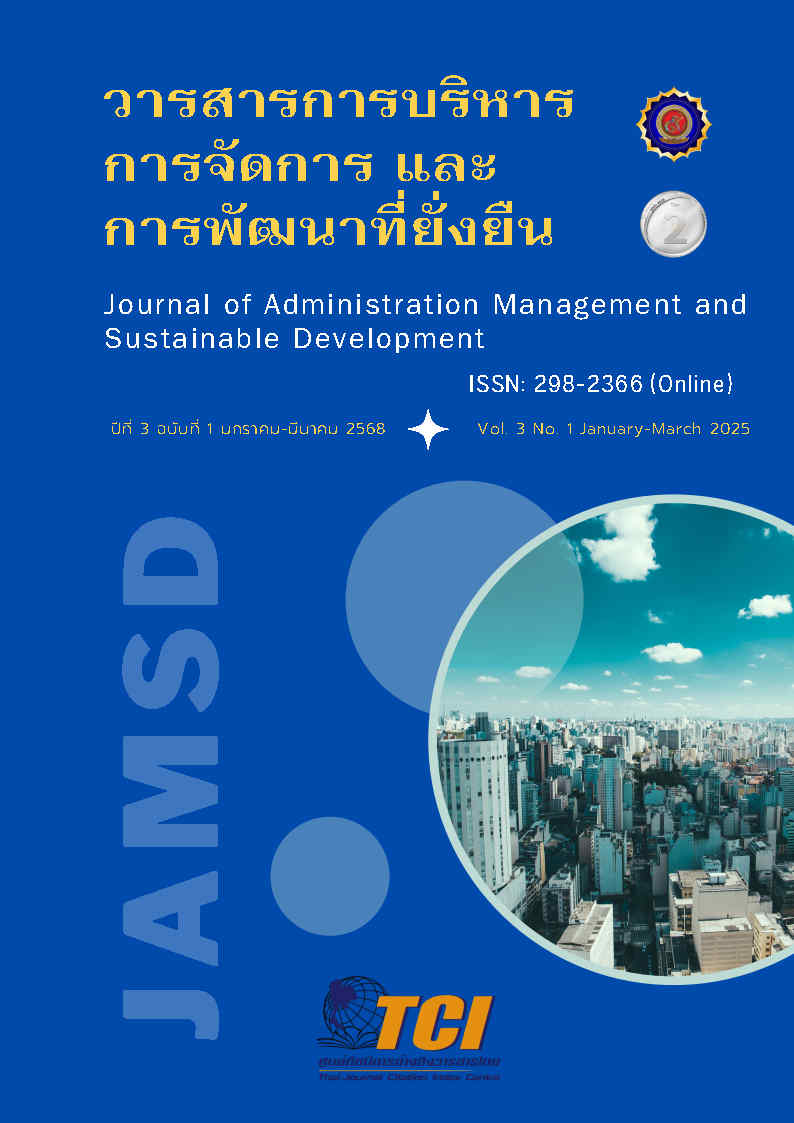Co-production in local flood disaster management: Case study in Prik Subdistrict Municipality, Sadao District, Songkhla Province
Co-production in Local Flood Disaster Management: Case Study in Prik Subdistrict Municipality, Sadao District, Songkhla Province
Keywords:
Co-production, flood disaster management, community-based flood disaster managementAbstract
The objectives of this research were to 1. examine the process for managing flood disasters in Prik Subdistrict Municipality, Sadao District, Songkhla Province. 2. The study also focused on the co-production in flood disaster management between the Prik Subdistrict Municipality and local communities. 3. Look into the issues and problems that slowed down co-production in handling flood disasters; and 4. Make suggestions for improving co-production in handling flood disasters in Prik Subdistrict Municipality, Sadao District, Songkhla Province. This study utilized a qualitative research methodology, collecting data through non-participation observation and semi-structured interviews. The thirty-seven key informants included agency representatives involved with flood disaster management in Prik Subdistrict Municipality, as well as community leaders and members of communities affected by the flood disaster. The result of this research found that 1. the process for managing flood disasters in Prik Subdistrict Municipality consisted of three stages, following the local administrative organization’s disaster prevention and mitigation plan, as followed: 1) The pre-disaster stage focused on preparedness for flood disaster response, which aimed to reduce impacts and losses. 2) During the disaster stage when the flood occurred, the municipality served as the primary agency responsible for managing the situation and restoring normalcy as quickly as possible, and 3) the post-disaster stage involved recovery efforts, including damage assessment and surveys. 2. Communities participated in co-production in flood disaster management as affected stakeholders who shared collective memories of severe flood disaster. 4. The lack of preparedness, which led to increased damage, necessitated their participation in problem-solving. The co-production of flood management arose due to limitations in resources and authority that prevented the municipality from handling the situation independently. And 4. sustainable flood resilience stemmed from awareness and collective lesson-learning to build a community capable of living with floods.
References
งานป้องกันและบรรเทาสาธารณภัย สำนักงานปลัดเทศบาลตำบลปริก. (2564). แผนปฏิบัติการป้องกันและบรรเทาสาธารณภัย พ.ศ. 2564-2570. สงขลา: ฝ่ายปกครอง สำนักปลัดเทศบาลตำบลปริก. https://www.tonprik.go.th/files/com_networknews/2023-06_7f00567bd637c40.pdf
ทวิดา กมลเวชช. (2564). รัฐ ท้องถิ่น: ต้นทางแห่งอำนาจและปลายทางของศักยภาพการจัดการวิกฤตพื้นที่เสี่ยงภัย (พิมพ์ครั้งที่ 2). กรุงเทพฯ: สถาบันพระปกเกล้า.
พระราชบัญญัติป้องกันและบรรเทาสาธารณภัย พ.ศ. 2550. (2550, 7 กันยายน). ราชกิจจานุเบกษา. เล่ม 124 ตอนที่ 52ก. หน้า 1-23.
เพิ่มพร รวมเมฆ. (2557). การจัดการภัยพิบัติโดยอาศัยชุมชนเป็นฐานภายใต้นโยบายการกระจายอำนาจ: กรณีศึกษา เทศบาลนครปากเกร็ด. วิทยานิพนธ์รัฐประศาสนศาสตรมหาบัณฑิต สาขาวิชารัฐประศาสนศาสตร์ จุฬาลงกรณ์มหาวิทยาลัย.
รัฐธรรมนูญแห่งราชอาณาจักรไทย พุทธศักราช 2560 (แก้ไขเพิ่มเติมถึงปัจจุบัน) (2564, 21 พฤศจิกายน). ราชกิจจานุเบกษา. เล่ม 138 ตอนที่ 76ก. หน้า 1-224.
สัญญาศรณ์ สวัสดิ์ไธสง. (2567). การบริหารจัดการแบบมีส่วนร่วม: แนวทางการสร้างพลังความร่วมมือในองค์การ. วารสารการบริหาร การจัดการ และการพัฒนาที่ยั่งยืน, 2(4), 841-852.
สุภางค์ จันทวานิช. (2556). การวิเคราะห์ข้อมูลในการวิจัยเชิงคุณภาพ (พิมพ์ครั้งที่ 11). กรุงเทพฯ: สำนักพิมพ์แห่งจุฬาลงกรณ์มหาวิทยาลัย.
อรุณี สัณฐิติวณิชย์. (2557). การร่วมกันจัดบริการสาธารณะระดับท้องถิ่นของพลเมือง: กรณีศึกษาการจัดการขยะของชุมชนชลประทาน จังหวัดอุบลราชธานี. วารสารวิชาการ Veridian E-Journal, 7(1), 625-635.
อรุณี สัณฐิติวณิชย์. (2558). การร่วมมกันจัดการขยะมูลฝอย: กรณีศึกษาเทศบาลนครอุบลราชธานี. วารสารมนุษยศาสตร์และสังคมศาสตร์, 6(2), 22-34.
อัญชิรญา จันทรปิฎก. (2563). บทวิเคราะห์ “บทบาทรัฐ-สาธารณะ” ในการจัดบริการสาธารณะตามแนวคิดการร่วมผลิต. วารสารมหาวิทยาลัยราชภัฏยะลา, 15(2), 240-247.
Abarquez, I., & Murshed, Z. (2004). Community-based Disaster Risk Management: Field Practitioners’ Handbook. Pathumthani: Asian Disaster Preparedness Center.
Kooiman, J. (2000). Societal Governance: Levels, Modes, and Orders of Social Political Interaction. In Pierre, J. (Ed.). Debating Governance: Authority, Steering, and Democracy (pp. 138-164). New York: Oxford University Press.
Sinhasema, S. (2017). Citizen Empowerment: Institutional Collaboration between Pak Kret Municipality and Its Community in the 2011 Flood Disaster Management. Journal of Social Sciences, Naresuan University, 13(1), 163-180.
Srikandini, A. G., Voorst, R. V., & Hilhorst, D. (2018). Disaster Risk Governance in Indonesia and Myanmar: The Practice of Co-governance. Politics and Governance, 6(3), 180-189.
Weber, M. (2011). Bureaucracy. In Ott, J. S., Shafritz, J. M, & Jang, Y. S. (Eds). Classic Reading in Organization Theory (7th ed., pp. 77-82). Boston, MA: Wadsworth.





